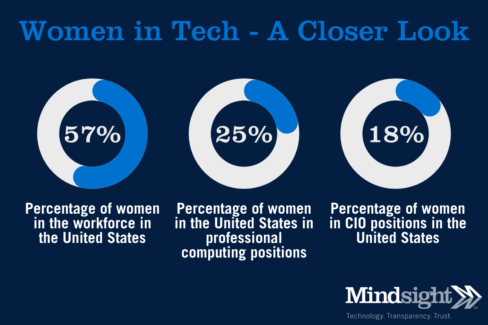July 13, 2021
First, some good news: In 2019, the U.S. Bureau of Labor Statistics predicted that 531,000 computer and information technology jobs would be added by 2029. That’s an impressive growth rate of 11 percent, “much faster than the average for all occupations.”
Now, some less good news: Far more men than women will perform those jobs. Which should come as no surprise.
A Look at the Numbers
The percentage of women in tech has long been disproportionately small. Over the past few decades, in fact, it’s gotten smaller. According to a recent report by the National Center for Women & Information Technology (NCWIT), while women comprise 57 percent of the U.S. workforce, they make up only 25 percent of professional computing occupations and only 18 percent of CIO positions.
Educational disparities have a huge negative impact. From heavily male-dominated math and science faculties at the high school and college levels to insufficient academic outreach, less effort is made early on to bring women into the fold.
“Our education system is simply not set up to close the gender gap in tech,” Tarika Barrett, CEO of Girls Who Code, told the Wall Street Journal in June. According to the Journal, Barrett’s organization and others like it — including one called Break Through Tech at Cornell Tech in New York City — are “giving students enrichment programs, setting them up with female mentors as role models, grounding their course work in real-world problems to keep it relevant—and sometimes… mediating with potential employers.”
Other mentoring programs such as Ada’s List and the League of Women Coders have the same goals. NCWIT even offers an online course titled “Introduction to Diversifying Undergraduate Computer Programs” that features “NCWIT social scientists and others from partner organizations, and from faculty and administrators who have implemented successful initiatives.”
Other Factors
 There’s a societal component as well, one that operates outside of educational institutions and the workplace. In 2015, the American Association of University Women (AAUW) published ten tips to get more women into engineering and tech. They’re as relevant today as they were then. Among them: 1) Remember that engineers are made, not born. One of the biggest hurdles to recruiting women is the idea that math and science prowess is inherent. The truth is, you can learn to be a great programmer or engineer. The brain is a muscle that needs to be worked to get stronger. 2) Let the girls in your life tinker with things, break toys, get dirty, and fail. And let them know that adversity is common in these fields. Learning from and moving past failure is part of the design process. 3) Spread the word that engineering and computing fields have enormous social impact. Women, on average, prioritize “communal goals” in their careers, meaning that they value working with and helping people. Engineers and tech workers can engineer an artificial limb, come up with solutions for drought and famine, and prevent cyberattacks.
There’s a societal component as well, one that operates outside of educational institutions and the workplace. In 2015, the American Association of University Women (AAUW) published ten tips to get more women into engineering and tech. They’re as relevant today as they were then. Among them: 1) Remember that engineers are made, not born. One of the biggest hurdles to recruiting women is the idea that math and science prowess is inherent. The truth is, you can learn to be a great programmer or engineer. The brain is a muscle that needs to be worked to get stronger. 2) Let the girls in your life tinker with things, break toys, get dirty, and fail. And let them know that adversity is common in these fields. Learning from and moving past failure is part of the design process. 3) Spread the word that engineering and computing fields have enormous social impact. Women, on average, prioritize “communal goals” in their careers, meaning that they value working with and helping people. Engineers and tech workers can engineer an artificial limb, come up with solutions for drought and famine, and prevent cyberattacks.
Lack of representation in male-dominated workplaces and workplace discrimination only compound the problem. On that front, according to a recent report by TrustRadius, women in tech are facing “historic challenges” following the COVID-19 pandemic. A few of the report’s many findings include: 1) 72 percent of women in tech have worked at a company where “bro culture” is pervasive. This is about the same as last year when 71% of women reported experiencing bro culture. Only 41% of men say the same. 2) In 2021, 72 percent of women in tech are outnumbered by men in business meetings by at least a 2:1 ratio. 3) In 2021, women in tech are four times more likely than men to see gender bias as an obstacle to promotion. Nearly 2 in 5 women felt that their gender was a barrier to being considered for their next promotion.
There’s also a persistent pay gap, with women making significantly less than their male counterparts for doing the same job. “In the tech industry, what starts at the biggest companies often trickles down to smaller ones,” according to the career site Dice.com “It’s potentially good news if firms large and small actively attempt to diversify their employee rankings and talent pipelines. However, Dice’s data also makes it clear that these diversity efforts—as halting and incremental as they might seem at moments—aren’t necessarily closing the gender pay gap, especially in crucial roles such as data, security, and software engineering.”
When Trust Radio asked survey respondents what the tech community could do to support women in tech, ideas ran the gamut: Equal maternity and paternity leave; unconscious bias training; flexible scheduling and location options; more mentorship opportunities; and the promotion of more women to leadership positions.
Despite these efforts and many others, however, there’s still a long way to go. But plenty of women tech leaders see brighter days ahead.
“One of the conversations I feel has had a detrimental effect on the movement is around women being physiologically (or in any other way) predisposed to fail in STEM or tech,” senior Google engineer Neha Pattan told Entrepreneur magazine. “I’m not sure how anyone can even come up with this stuff. Having to justify why this is wrong and talk about how women have equal aptitude for analytical thinking and logical reasoning is exhausting. Women are here to stay and here to lead — let’s accept it and move on.”
About Mindsight
Mindsight, a Chicago IT services provider, is an extension of your team. Our culture is built on transparency and trust, and our team is made up of extraordinary people – the kinds of people you would hire. We have one of the largest expert-level engineering teams delivering the full spectrum of IT services and solutions, from cloud to infrastructure, collaboration to contact center. Our customers rely on our thought leadership, responsiveness, and dedication to solving their toughest technology challenges.